|
|
||||||||
 |
||||
|
|
||||||||||||||||||||||||||||||||||||||||||||||||||||||||||||||||||||||||||||||||||||||||||||||||||||||||||||||||||||||||||||||||
| THINGS
TO DO AND NOTICE:
What colored line is a continuation of the white line? Angles of the Lines Drag the white line with your mouse so that the lines are horizontal. This causes the angular displacement illusion to disappear. Gradually increase the angle of the lines away from the horizontal. This causes the illusion to increase. Width of the Parallel Bar Drag the right side of the vertical bar (not the middle -- that will cause the bar to disappear). This will make the middle vertical bar wider. This also produces a variation in your perception of the angular displacement. A larger width causes a larger perceptual displacement. The largest displacement is obtained when the bar is at its maximum width and the oblique lines are at their maximum angle from the horizontal. Does the Vertical Grey Bar Make a Difference? Set the parameters of this illusion so that you can see the illusion clearly. Click on the middle of the vertical bar with your mouse. This will cause the bar to disappear (clicking on the middle again will cause the bar to reappear). Does the appearance or disappearance of the bar have any influence on your perception of the strength of the illusion? Most likely, when the bar disappears, the illusion is slightly stronger. What's Going On? The white line always always intersects with the yellow line, even though you may not perceive it that way. The Poggendorf illusion is one of the most famous distortion illusions known. Although much has been written about it since its discovery in 1860, the underlying mechanism that gives rise to this effect is still not well understood. An adequate explanation of the Poggendorf illusion must take all the above factors into account, as well as several others. For example, the Poggendorf illusion is not confined to two-dimensional representations: It also occurs with three-dimensional objects. Secondly, perspective cues can have a drastic effect on diminishing the effect of this illusion. While the Poggendorf illusion is over 100 years old (it was discovered in 1860), there have been no end of theories to try to account for it. Recently, interactive versions have revealed new characteristics and variations of this illusion. There is, unfortunately, no theory to date that will adequately account for all the variations perceived. It is worthwhile, however, to examine the two most popular theories advanced so far to explain this illusion. Angular Displacement Theory A theory that was popular for many years, which had its origins in the theories of the nineteenth-century physicist Hermann von Helmholtz, and even had a neuronal underpinning, was based on the overestimation of acute angles. It was suggested that we have orientation detectors that exaggerate all acute angles and minimize all obtuse angles. This theory has its basis in the exciting work of Hubel and Wiesel who discovered that cells in the visual cortex of a cat "detect" contour orientation on the retina. Hubel and Wiesel, who recorded activity from single cells of the area striata of the cat's brain while presenting the cat with simple visual shapes, found that some cells were only active when a bar of light was presented at a certain angle. Different cells would respond to different angles. The presence of an adjacent contour of a different orientation would have the effect of lateral inhibition, where activity on one nerve cell reduced the effect on adjacent neurons. While the overestimation of acute angles occurs in some distortion illusions, it does not fully explain what is going on in the Poggendorf illusion. This is particularly evident when we get rid of the middle bar. The illusion is still present, even though there is no actual vertical contour to form acute or obtuse angles. There is no contour present that can be attributed to lateral inhibition of the contour-orientation cells. |
|||||||||||||||||
 |
|||||||||||||||||
| As
another control, one can eliminate either the acute or obtuse angles and
see how the illusion is affected. The illusion remains when one removes
the acute angle; however, removing the obtuse angle has little or no effect.
Depth-Processing or Constancy Theory Another popular theory proposes that your perceptual system processes this figure as a three-dimensional object, not as a two-dimensional figure. In the case of the Poggendorf illusion, the oblique lines are perceived as the outlines of apparently receding horizontal surfaces that lie on different planes, whereas the central rectangle is perceived as lying on a single plane in front of the viewer. |
|||||||||||||||||
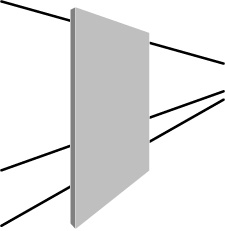 |
|||||||||||||||||
 |
|||||||||||||||||
|
This is made clearer in the left figure where the oblique lines (a and
b) are processed as belonging to different horizontal planes rather than
as a single continuous receding plane. The oblique lines are processed
as edges in a horizontal plane. The angles formed between the vertical
and oblique lines are interpreted as right angles. According to this theory,
all angles are misperceived: Acute angles are overestimated and obtuse
angles are underestimated. But misperception of angle has a very different
meaning here: The misperception is one of perspective representation, not
of two-dimensional distortion.
If this is the case, it follows that if the rectangle of the figure is changed to depict a surface that appears to recede into the distance in the same apparent orientation as the oblique lines, the illusory misalignment effect should weaken. This is what does happen, as can be seen in the figure on the upper right. Yet the angular displacement theory would predict the persistence of the illusion in this case, because the angles formed by the vertical and the oblique lines remain unchanged.
|
|||||||||||||||||
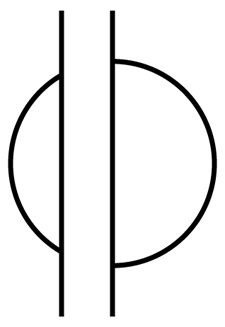 |
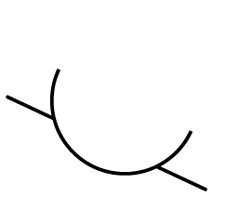 |
 |
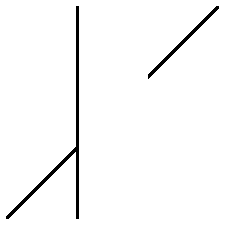 |
||||||||||||||
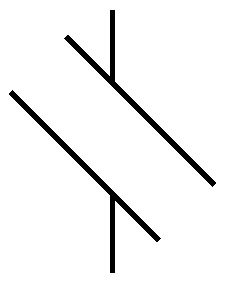 |
|||||||||||||||||
|
The Depth Processing theory fails, however, because it does not completely
explain the full range of Poggendorff variations, several of which are
seen directly above. In these figures, you can see variations of the Poggendorff
illusion that contain no apparent perspective features. Also, the depth-processing
theory does not account for the observation that when the standard Poggendorff
figure is tilted so that the interrupted oblique lines are set vertically
at 90 degrees or horizontally at 180 degrees, the illusory misalignment
effect
weakens or disappears. Merely tilting the figure should not change any
presumed perspective features of the figure.
This indicates that the Poggendorff illusion is still not fully understood. History of the Poggendorf Illusion The Poggendorff illusion was actually derived from another famous illusion -- the Zöllner illusion. In 1860, J. C. Poggendorf, the editor of a journal of physics and chemistry, received a monograph from F. Zöllner, an astronomer, that described an illusion he accidentally noticed on a cloth pattern. Zöllner's illusion shows that parallel lines intersected by a pattern of short diagonal lines appear to diverge. Poggendorff noticed and described another effect of the apparent misalignment of the diagonal lines in Zöllner's figure. Thus the Poggendorff illusion was discovered. REFERENCES: Coren, Stanley and J. S. Gigus, 1978. Seeing is Deceiving: The Psychology of Visual Illusion, New Jersey, Lawrence Erlbaum. Coren, Stanley and J.S. Girgus, 1978. "Visual illusions," in R. Held, H. W. Leibowitz, and H. L. Teuber, eds., Handbook of Sensory Physiology, vol. III: Perception, New York, Springer-Verlag. Gilliam, Barbara, 1971. "A depth processing theory of the Poggendorff illusion," Perception & Psychophysics, 10, 211-216. Gillam, Barbara, 1980, "Geometrical illusions," Scientific American, 242, 102-111. Greene, E., and M. Verloop., 1994. "Anomalous and luminance contours produce similar angular induction effects," Perception, 23, 147-156. Greene, E., and J. Fisher, 1993. "Classical illusion effects with nonclassic stimuli: Angular induction from decomposing lines into point arrays, Perception & Psychophysics, 56, 575-589. Greene, E., 1988. "The corner Poggendorff," Perception, 17, 65-70. Lucas, A., and G. H. Fisher, 1969. "Illusions in concrete situations: II Experimental studies of the Poggendorff illusion," Ergonomics, 12, 395-402. Masini, R., R. Sciaky, et. al., 1992. "The orientation of a parallel-line texture between the verticals can modify the strength of the Poggendorff illusion," Perception & Psychophysics, 33, 235-242. Poulton, E. C., 1985. "Geometric illusions in reading graphs," Perception & Psychophysics, 37, 543-548. Robinson, J. O., 1972. The Psychology of Visual Illusion, London, Hutchinson. Rock, Irvin, 1984. Perception, New York, W.H. Freeman. Schiffman, Harvey, 1995. Sensation and Perception, New York, John Wiley & Sons. Spivey-Knowlton, M. J. and B. Bridgeman, 1993.
""Spatial context affects the Poggendorff illusion," Perception &
Psychophysics, 53, 467-474.
|
|||||||||||||||||